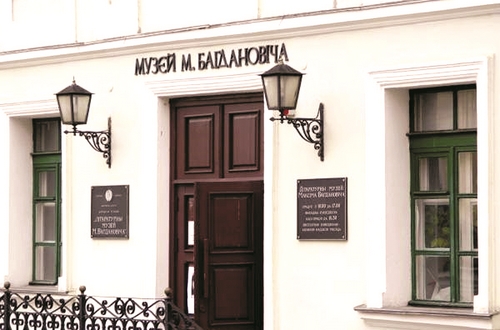Today, the museum is a centre of collection, storage, study and popularisation of the creative legacy of the classical poet of Belarusian literature. The exhibition synthesises Maxim Bogdanovich’s life and his spiritual world.

Entrance to Maxim Bogdanovich Museum
Displayed in modern style, with late 19th-early 20th century elements in the decoration of the ceiling, the museum uses niches to display particular items, such as the complex drawing of straw items. Furniture and stained glass windows create a certain atmosphere for the deeply symbolic collection. It reflects a particular period of the poet’s life, being closely connected with his creativity and resonating with cycles of lyrics from his Venok (Wreath) collection.
The first hall shows items from Maxim Bogdanovich’s childhood and adolescence, telling us about his parents and his ancestors, while revealing the roots of his talent and the variety of his personality.
The second hall reflects the establishment of Bogdanovich’s creative individuality. His literary debut took place in 1907, in Nasha Niva (a Belarusian newspaper) with his Musician story. It features ‘iconostasis’: twelve portraits of figures of Belarusian culture in the first row and those of Belarusian writers of the late 19th-early 20th century in the second row.
The third hall is dedicated to Maxim Bogdanovich’s flourishing talent, dominated by his Wreath collection of poems, and exhibits which reveal the creative creed of the ‘Pesnyar of pure beauty’. Maxim Bogdanovich was a talented poet, prose writer, critic, publicist and journalist.
The ‘Madonna Hall’ differs from the others in presenting exhibits in a different way. The Madonna was one of the central images in Maxim Bogdanovich’s creativity.
Books comprise the bulk of the museum’s collection, including five copies of Maxim Bogdanovich’s collection of poems released during his lifetime, books from the poet’s circle of reading, literature about his life and creativity, and books by late 19th and early 20th century Belarusian poets and writers, alongside translations and dedications.
Manuscripts comprise a considerable part of the collection, including a collection by Bogdanovich entitled Zelenya (Young Shoots). There are autographed copies of his poems I Recollect the Old House and I’m A Sick Wingless Poet…, alongside recollections about the poet, manuscripts by his relatives and friends, and autographs of other Belarusian figures of culture and arts. The audio and video section boasts 6,000 photos and negatives of Maxim Bogdanovich, his relatives, acquaintances, friends and researchers, as well as places connected with his life and name. The collection also keeps films about the poet, phono-records, discs and recordings of his poetry, as well as songs and musical compositions inspired by his verse. There are recordings of solemn events and of recollections.
The classic of Belarusian literature has inspired painters to create numerous sculptures and paintings, many of which feature in the museum’s collection. There are also over a thousand household and ethnographic items, furniture, embroidered pieces and clothes, enabling us to reflect on living conditions in the late 19th and early 20th century.
The Maxim Bogdanovich State Literary Museum has two branches: at Belaruskaya Khatka in Minsk, and at Rakutevshchina Estate in the Molodechno District’s Rakutevshchina village.
By Mikhail Veremeev











